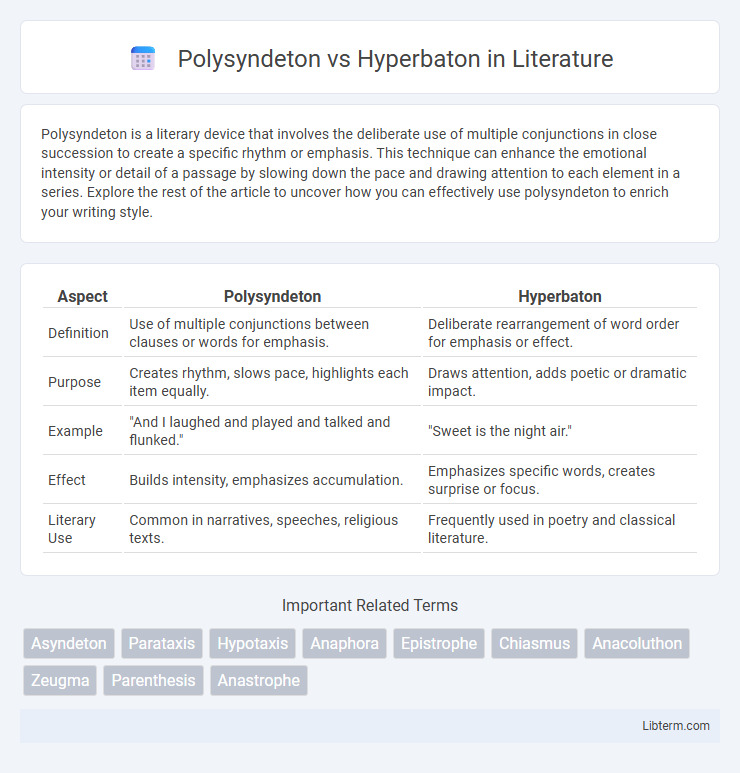Polysyndeton is a literary device that involves the deliberate use of multiple conjunctions in close succession to create a specific rhythm or emphasis. This technique can enhance the emotional intensity or detail of a passage by slowing down the pace and drawing attention to each element in a series. Explore the rest of the article to uncover how you can effectively use polysyndeton to enrich your writing style.
Table of Comparison
| Aspect | Polysyndeton | Hyperbaton |
|---|---|---|
| Definition | Use of multiple conjunctions between clauses or words for emphasis. | Deliberate rearrangement of word order for emphasis or effect. |
| Purpose | Creates rhythm, slows pace, highlights each item equally. | Draws attention, adds poetic or dramatic impact. |
| Example | "And I laughed and played and talked and flunked." | "Sweet is the night air." |
| Effect | Builds intensity, emphasizes accumulation. | Emphasizes specific words, creates surprise or focus. |
| Literary Use | Common in narratives, speeches, religious texts. | Frequently used in poetry and classical literature. |
Introduction to Polysyndeton and Hyperbaton
Polysyndeton is a rhetorical device characterized by the deliberate use of multiple conjunctions between clauses or items in a list, enhancing the rhythm and emphasizing each element. Hyperbaton involves the unusual or inverted arrangement of words in a sentence, disrupting conventional syntax to create emphasis or poetic effect. Both techniques manipulate sentence structure to influence tone and reader perception in literature and speech.
Defining Polysyndeton: Meaning and Usage
Polysyndeton is a rhetorical device characterized by the deliberate and excessive use of conjunctions between words, phrases, or clauses, enhancing the rhythm and emphasis of a sentence. Commonly found in literature and speech, polysyndeton creates a feeling of abundance or intensity by linking elements such as "and," "or," and "but" repetitively. This technique contrasts with hyperbaton, which involves altering the conventional word order for emphasis or poetic effect, whereas polysyndeton maintains standard syntax while intensifying the flow through repeated conjunctions.
Exploring Hyperbaton: Structure and Purpose
Hyperbaton involves the deliberate rearrangement of standard word order in a sentence to create emphasis or highlight particular elements, often deviating from the subject-verb-object structure. This rhetorical device enhances the expressive power of language, drawing the reader's attention by disrupting expected patterns and thus intensifying the thematic or emotional impact. Unlike polysyndeton, which relies on multiple conjunctions to link clauses or phrases, hyperbaton manipulates syntactic positioning for stylistic effect and deeper nuanced meaning.
Key Differences Between Polysyndeton and Hyperbaton
Polysyndeton involves the deliberate use of multiple conjunctions between clauses or items to create emphasis, such as "and" repeated in a list, enhancing rhythm and intensity. Hyperbaton disrupts the conventional word order within a sentence, often placing adjectives after nouns or verbs before subjects, to produce dramatic or poetic effects. The key difference lies in polysyndeton's syntactic linking of elements with conjunctions versus hyperbaton's rearrangement of word sequences for stylistic impact.
Historical Origins and Literary Roots
Polysyndeton, rooted in ancient Greek and Latin rhetoric, emerged as a deliberate stylistic device to create rhythm and emphasize continuity by using repeated conjunctions, notably in works by Homer and Cicero. Hyperbaton, with origins in classical Latin poetry and prose, disrupts conventional word order to highlight specific terms or create a dramatic effect, appearing prominently in the writings of Virgil and later Latin authors. Both devices draw from classical traditions, shaping literary expression through distinct manipulation of syntax and conjunctions to enhance narrative and poetic impact.
Effects on Tone and Rhythm in Writing
Polysyndeton creates a deliberate, rhythmic cadence by repeatedly using conjunctions, which slows the pace and amplifies emphasis, generating a tone of urgency or solemnity. Hyperbaton disrupts normal word order, producing a striking, sometimes disorienting effect that draws attention to specific words or phrases, often enhancing a dramatic or poetic tone. Both rhetorical devices manipulate sentence flow to shape the reader's emotional experience and highlight key ideas through distinctive rhythmic patterns.
Famous Examples in Literature
Polysyndeton appears prominently in Charles Dickens' *A Tale of Two Cities*, with the repeated use of "and" in the opening line emphasizing the chaotic contrasts of the era. Hyperbaton is found in Shakespeare's *Julius Caesar*, where the inversion of word order in phrases like "This I must see" heightens dramatic tension and draws attention to key emotions. Both rhetorical devices enhance narrative impact by manipulating sentence structure for emphasis and rhythm.
When to Use Polysyndeton vs Hyperbaton
Polysyndeton is used to create a deliberate, rhythmic emphasis by linking multiple elements with conjunctions, making the passage feel more abundant or intense. Hyperbaton rearranges the conventional word order to highlight specific words or ideas, often adding a dramatic or poetic effect. Choose polysyndeton when you want to slow the pace and amplify detail, and use hyperbaton when aiming to emphasize or stylize particular words or phrases for impact.
Common Mistakes and Misunderstandings
Polysyndeton is often confused with simple lists, but the key error lies in overusing conjunctions, which can dilute the intended emphasis and overwhelm readers. Hyperbaton frequently leads to misunderstood sentence structure when word order is excessively altered, causing confusion about the subject or action. Common mistakes include misidentifying these rhetorical devices, with polysyndeton treated as mere repetition and hyperbaton mistaken for random word placement rather than purposeful syntactic inversion.
Enhancing Your Writing with Stylistic Devices
Polysyndeton enhances writing by deliberately using multiple conjunctions to create a rhythmic and emphatic effect, intensifying the reader's experience and emphasizing each element in a list. Hyperbaton rearranges the typical word order, adding a poetic or dramatic flair that draws attention to specific words or ideas, enriching sentence complexity. Employing these stylistic devices strategically elevates narrative voice and deepens textual resonance, making your writing more engaging and memorable.
Polysyndeton Infographic

 libterm.com
libterm.com